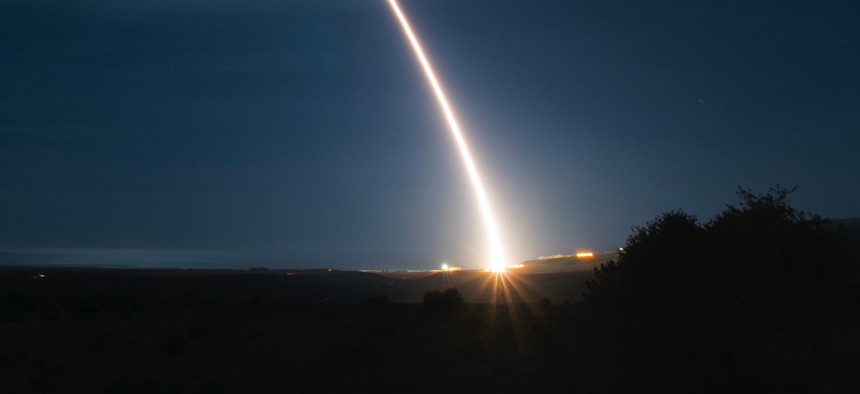
An unarmed Minuteman III intercontinental ballistic missile — one type of weapon constrained by New START — launches during a developmental test at Vandenberg Air Force Base, Calif., Feb. 5, 2020. Air Force Senior Airman Clayton Wear
Trump’s Bid to Go Big on Nuclear Arms Looks Like a Fizzle
Russia has no interest in negotiating from scratch. China has no interest in negotiating at all.
Nuclear arms control is in trouble. The 1987 Intermediate-range Nuclear Forces, or INF, Treaty is dead, and the 2010 New Strategic Arms Reduction Treaty, or New START, has entered its last year, with the Trump administration thus far unready to accept Moscow’s offer to extend it.
President Trump instead wants to go big. Last April, he reportedly tasked officials with developing a proposal to address all nuclear weapons, not just deployed strategic arms, and to bring China into the equation. Nine months later, nothing, not even the hint of an outline of a proposal, has emerged. That is no surprise.
Negotiate All Nukes? Nyet
The demise of the INF Treaty left New START as the only treaty constraining U.S. and Russian nuclear arms. New START limits the actual number of warheads on deployed strategic ballistic missiles with an accounting mechanism attributing one deployed warhead to each deployed bomber.
Related: New New START a Nonstarter: Russian Ambassador
Related: Top Nuke General: Russia Is Exploiting Gaps In Key Arms-Control Treaty
Related: Poll: Americans Want To Stay In Nuclear Arms Control Agreements
That leaves a lot of nuclear warheads unconstrained: weapons for deployed bombers (beyond one per deployed aircraft), reserve strategic warheads, and all non-strategic nuclear warheads (sometimes referred to as sub-strategic or tactical nuclear weapons). The United States had 1,376 deployed strategic warheads as of September 1, 2019, but the total arsenal size was believed to number 3,800 nuclear weapons.
Washington has long expressed interest in limits on non-strategic nuclear weapons. Following signature of New START, President Obama called for a follow-on negotiation to include all U.S. and Russian nuclear arms—strategic and non-strategic, deployed and non-deployed. The Russians, however, have long said nyet: they are not prepared to discuss non-strategic nuclear weapons unless the United States discusses issues of concern to them, including missile defense and long-range, precision-guided conventional strike.
Russian concerns about the capabilities of current U.S. missile defenses are hugely overstated, but Moscow fears what those missile defenses might prove capable of doing in the future. The Trump administration, however, has a clear position on limiting missile defense limits as expressed in its missile defense review: no constraints.
As for conventional strike systems, Russian strategists—rightly or wrongly—have expressed concern for more than a decade about a U.S. strategic attack with precision-guided conventional weapons. The U.S. military deploys thousands of conventionally-armed sea-launched and air-launched cruise missiles, comprising a critical element of U.S. power projection. The Pentagon has shown no interest in limiting these.
If the Trump administration will not discuss constraints on missile defenses or long-range, precision-guided conventional strike systems, it should not expect success in persuading the Russians to put non-strategic nuclear arms on the table. That is even more the case if China, whose growing conventional power worries Moscow, chooses not to join the negotiating game.
Bring in China? Bu shi
China will not join the negotiating game. Chinese officials have repeatedly said that they would not participate in nuclear arms negotiations until there is a significant narrowing of the gap between their nuclear arsenal (about 300 nuclear weapons) and those of the United States and Russia (3,800 to 4,500).
One challenge with such a trilateral negotiation would be what limit to negotiate. The United States and Russia would hardly agree to come down to 300 total nuclear weapons. Nor would they agree to a limit letting China build up to 3,800 to 4,500. And Washington and Moscow almost certainly would not accept an equal limit with China somewhere in between.
Russian officials have already illustrated this dilemma. They began calling for a multilateral negotiation on nuclear arms in 2011 (a negotiation that would involve more than China). Over the past nine years, however, they have never put forward any concept for what a limitation regime would look like. That is because the only regime acceptable to the two nuclear superpowers would impose unequal limits on China. Beijing will not go for that.
Moreover, missile defense sits at the top of China’s list of concerns. With a much smaller nuclear force than Russia, Beijing worries even more that U.S. missile defenses, following a U.S. first strike (perhaps largely carried out with conventional weapons) would blunt a ragged Chinese retaliatory attack. The Trump administration will not entertain limits on missile defenses.
Heading for a Fizzle? Da
Last April’s presidential request to develop a proposal to go big on nuclear arms reductions has all the hallmarks of a Trump initiative: impetuous, seeking to grab headlines, and not well thought-out. More than nine months later, Washington has offered no proposal for a negotiation covering all nuclear arms and involving China—or even the bare outline of a proposed limitation regime.
That speaks volumes. And it should come as no surprise that officials responsible for arms control at the State and Defense Departments have not come up with a position to answer the president’s dramatic tasking. John Bolton, national security advisor when Mr. Trump leveled his tasking, may well have wanted this. He has shown himself to be no fan of arms control.
In Mr. Trump’s desire to grab the spotlight and go big, he set unachievable goals. Prepare for a fizzle.




